Antarctica/Portraits, Soft Natural Light

|
• Tangalooma Wild Dolphin Resort • Quality Inn Presidential • Best Western Fairway Motor Inn • Best Western Sea Spray Motel |
Feature Photograph

The above photograph was taken last week and is of the new yet to be opened BTS Skytrain station at Patthanakan and Srinakharin.
This image is significant not because it’s a great photograph (it’s not), but because it’s bringing you news and a visual together. Images become significant for a variety of reasons and great quality and technicals often aren’t required. A solid composition helps, but isn’t mandatory either.
If you look through your local newspapers you’ll see many photographs which are significant only because they give you a visual on some piece of interesting news, or an interesting story of some type. Ideally an image will stand on its own, no story needed. Conversely ideally a story will stand on its own, no image necessary. However, most often an image compliments a story, or a story an image, and standing together they reach our “interest threshold” where alone they otherwise wouldn’t.
Why is this BTS Skytrain station interesting? Because it’s on the major link / route that will connect the inner city BTS system to the international airport! Once this link is open you’ll be able to jump on the BTS at the airport terminal, and in minutes you’ll be getting off at the Nana BTS, a short walk across the street from what is perhaps Bangkok’s most famous hotel. How cool is that? No more corrupt taxi drivers, no more limo shams, and no more hair raising thrill rides along the Expressway with a yaba crazed taxi driver at the wheel.

When will the link open? I really don’t know and I no longer believe the official dates as they’ve been delayed several times. The above picture was taken almost three years ago and at the time we were told completion was scheduled in 12 months. Since, we’ve had a coup, political demonstrations, and now a weak economy, all of which had the effect of bringing the project to a standstill. Eventually, work restarts and progress continues.
Two weeks ago I noticed a full length skytrain creeping down the track at 5 – 10 km/h. Days later one whizzed by at full speed. This tells me the track has been finished and tested. In the feature photograph you can make out skytrain cars parked at intervals along its length? Perhaps this is part of load testing? It appears that only the actual passenger loading stations have yet to be fully completed, but they’re well on their way. If anyone knows the details please email me, I promise to keep your identity to myself and will pass any information you have along to the readers.
Antarctica Baby!
As you know I sometimes solicit material from accomplished and interesting fellow photographers. Dr. Palazzolo is a friend and a colleague and I’m delighted to introduce him to you in this column. Dr. Palazzolo is an avid traveler, exotic animal veterinarian, and a wildlife conservationist. He teaches digital photography workshops on his exotic trips, and shares his professional equipment with his students to help increase the chance they’ll come home with those ‘once-in-a-lifetime’ photographs to show off to their friends. Even though most of his trips are in Africa, South America, and Alaska, he’s had the opportunity to teach photography to a group of veterinarians on an Antarctic expedition. I hope to bring Dr. Palazzolo to Thailand and include him in future workshops while showing him all Thailand has to offer!
Dr. Palazzolo’s stated philosophy concerning photography is as follows:
“My goal in photography is to capture a unique moment and share it with others. It is not to take a perfect photo regarding shadows and highlights, nor is it to get my photos on the cover of some magazine. It is to share what I see with others and present it in a manner that all can relate to and learn from.”

Lucky Number 7- Antarctica
Finally, after traveling halfway around the world I am on the Explorer II as it leaves the southernmost city in the world called Ushuia- next stop Antarctica! Well, not exactly- the next stop in my mind is the Drake Passage, some of the most turbulent waters on the planet, and the body of water we need to traverse for the next two days. I must admit that seeing those vomit bags scattered around the ship did nothing for my confidence in this area. I am keeping my fingers crossed that my anti motion medication works, especially when I lecture to our group of 30 veterinarians. The rainbow I see as we leave port gives me hope – my 7th continent, here I come.




My worries were unfounded as we crossed what our expedition crew affectionately called the “Drake Lake”. On the ride out we were visited by petrels and albatross that spend their lives wandering these waters. They are attracted to the boat and entertained us by streaking past in the ample winds as we all tried to focus on them with our fancy cameras. This was a good time for us to practice our focusing techniques for the opportunities to come.


During our two-day voyage across the Drake we had the good fortune to happen across 25 humpback whales early in our trip. Maritime law dictates that you do not approach marine mammals within one hundred yards. These animals do not have to follow this law though, and when your enthusiastic Italian captain tells you to get on deck pronto as he turns the engines down you sometimes get lucky and they approach your ship.

They were feeding on a massive krill swarm just below the ship. When the captain announced this find (he was more excited than we were) we all scurried to the deck with our cameras in tow. The whales circled our ship and put on a show as they dove and surfaced, displaying their beautiful flukes, and then repeating the process as they fed. In the clear waters we could observe them underwater swimming all around us. The calm Drake Passage (a 3 out of 10) and the whale sightings were good omens I hoped would continue.


On the ride out we were kept well fed and well informed by our professional (and irreverent I might add) expedition crew and Filipino staff. I had a feeling it would be a colorful trip when our captain, in spite of what our expedition briefing stated, told us that he would allow us to go on the bridge and watch them navigate around icebergs. Let's see, how exactly did he word it…” Buon giorno everyone, and welcome a to my a ship. You no worry about what your read about the bridge, you comma on my bridge any time you feel a like it”.
As we got near the Antarctic peninsula we started seeing penguins that were coming and going on feeding trips. The speed at which they literally fly through the water is in such contrast to the way they waddle on land. Between the whales, sea-going birds, and now these penguins, we had plenty of time to perfect our photographic techniques on moving objects as we arrived at the Antarctica Peninsula at a location called Deception Bay.
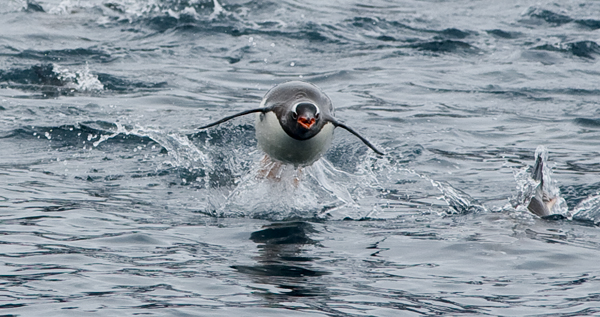

It was an old whaling station and British research station, and the first of many islands we would visit on our excursion. This was our first chance to don all our gear and head out in the zodiacs. For some of us the best part of our first Antarctic stop was taking a dip in the frigid waters at just the right spot where the thermals were bubbling up. I am now an official member of the Deception Island Hot Tub Club!
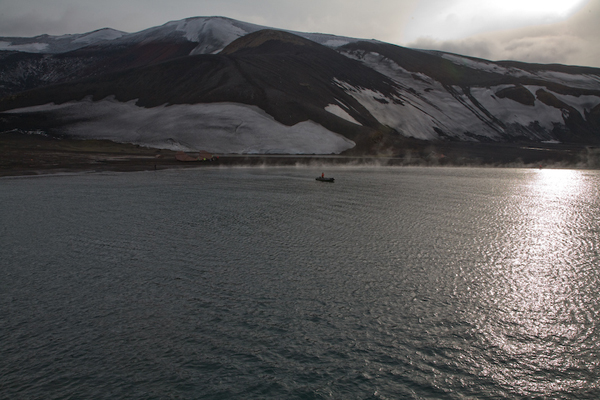

Over the next 5 days we would visit numerous locations on the peninsula and learn the storied history of this land. Our expedition crew was top notch, and in addition to lectures on the flora and fauna, an historian that was the great nephew of an early Antarctic explorer added a colorful slice of history to the early explorers that risked so much to navigate and map this huge continent. At the end of each day, at what was termed “recap” by the crew of the boat, they went over what we actually ended up observing. Their approach was a bit more irreverent than you might anticipate by such a professional crew, which added to the ambiance of the trip.
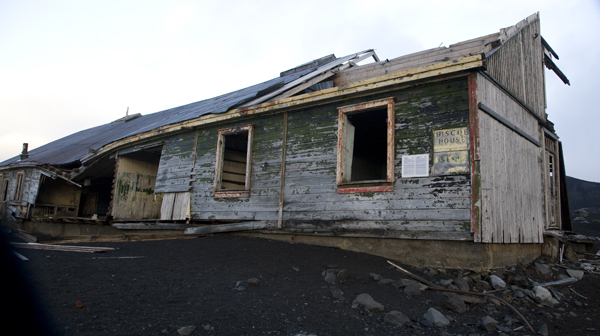
The highlight of the trip for almost everyone was our interaction with the penguins. If you like penguins then you will be in guano heaven! We were surrounded by them- chinstraps, gentoos, and adelies. We followed the strict rules about not approaching closer than 5 meters because of the stress they must endure during their molt. These rules did not apply to the penguins though, and if they waddled towards you and happened to nip at your toes then you made a new friend. To be allowed back on the ship we had to pass a crew inspection of our boots for guano. Offenders had to endure the indignity of the guano-matic to clean their boots or else they would be left on the island as our ship sailed to its next destination.
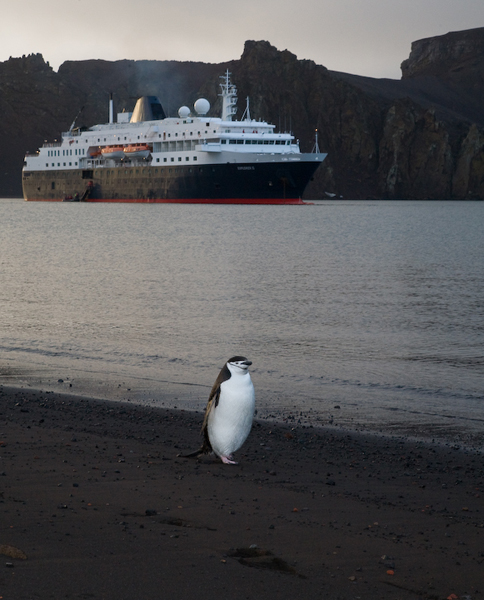
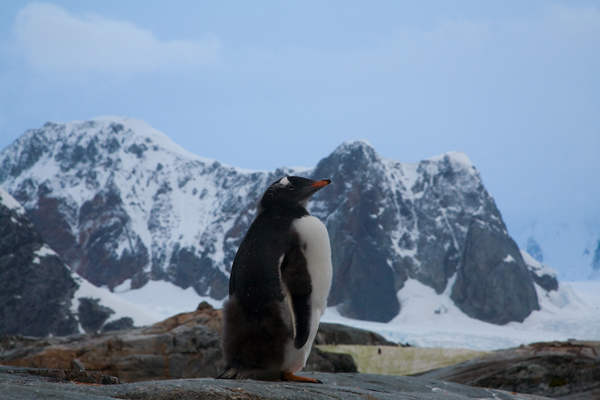
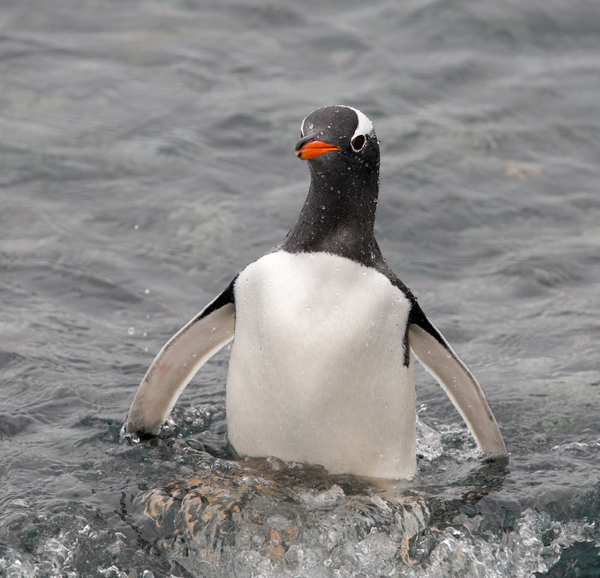
As ungainly as penguins are on land their movements in the water are graceful and fast as lightning. Herds of them would literally streak past us, popping up momentarily, then disappearing like torpedoes. If you wanted to capture them with your camera you had to focus on the water where you anticipated they would appear and start firing before you even saw them. Needless to say, as we edited our photos later, we had to review lots of out-of- focus and just plain water shots to get a few of them as they literally flew through the air.
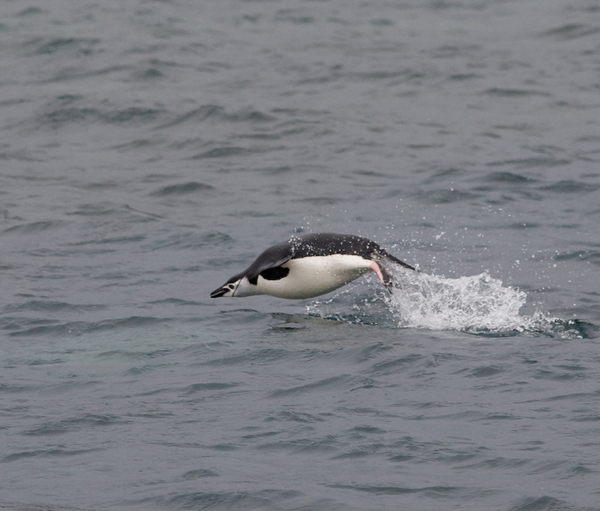
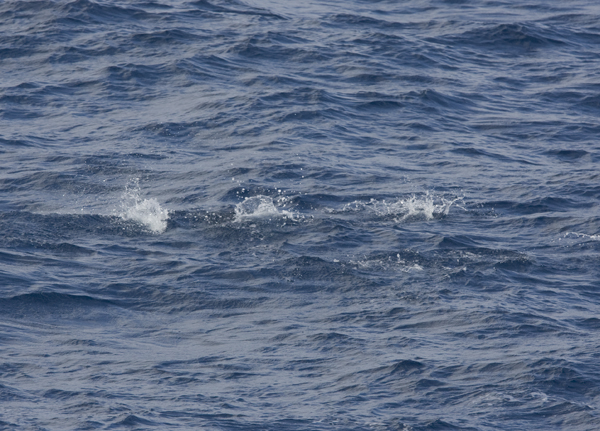
In addition to penguins we saw weddell seals, crab eating seals, and leopard seals. We basked in beautiful blue skies, helped our captain navigate around untold numbers of icebergs, ate massive quantities of food, contemplated huge glaciers, and marveled at the early explorers who risked so much to establish whaling settlements and map the continent.
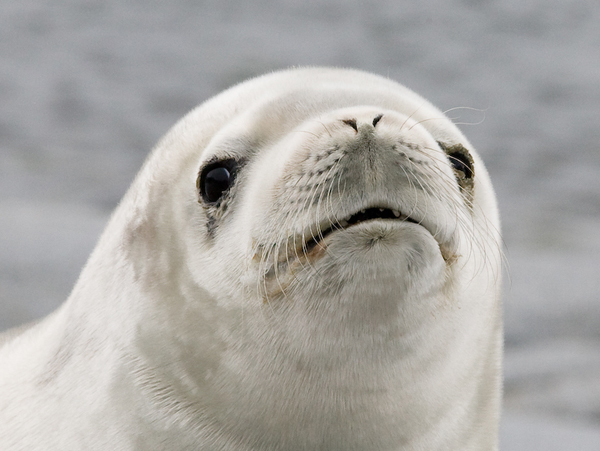
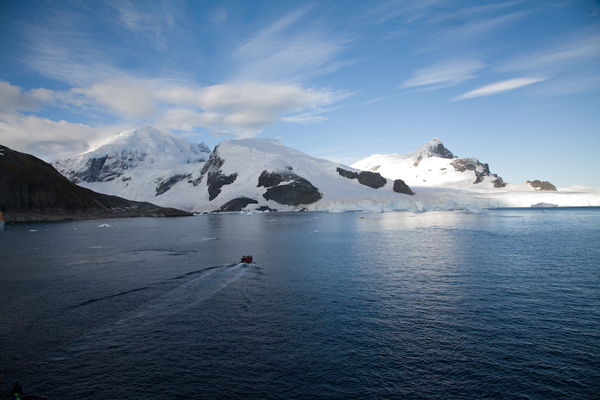
The stark beauty of Antarctica was apparent as the weather would change from blue skies and balmy seas to ominous skies and windswept waters in minutes during our daily zodiac excursions. This stark beauty was enhanced one day as we watched an awesome predator called a leopard seal tear apart and eat a bird. When we first encountered him he was checking us out by rising up out of the water. He would then dive under our zodiac and look at us from the other side. In no time he was gone and we got word he had a bird called a blue-eyed shag in his mouth.
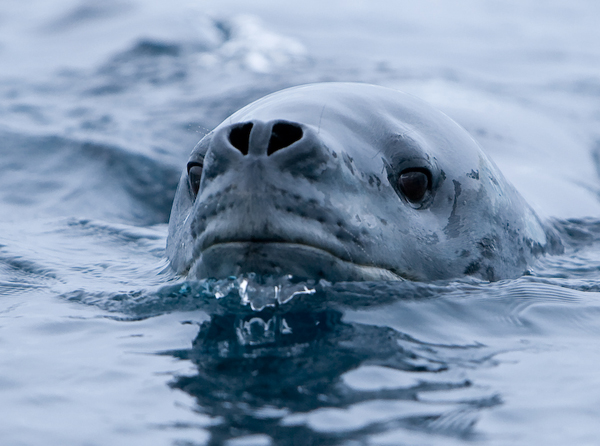
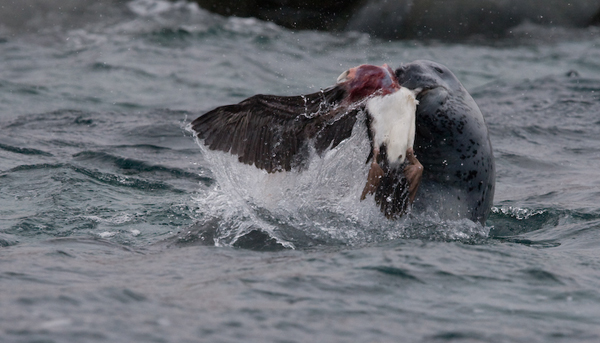
All too soon we had to end our trip and face the Drake again. Too bad for some in our group the ride back was not as calm as the ride over. The Richter Scale on the ride back was a 7 out of 10, which meant 30 foot waves, although the captain gave us permission to say they were 50 feet.
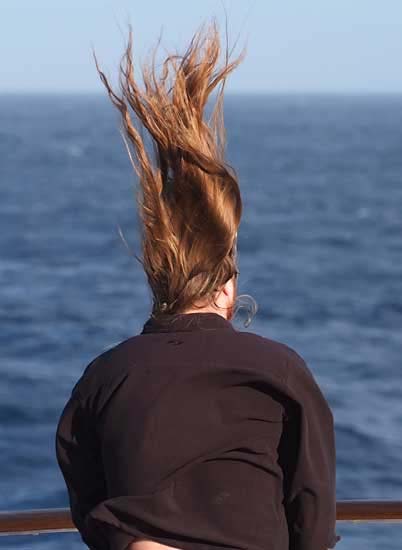
The crew of our boat (oops, I mean expedition ship) was outstanding, the food was great, the boat was comfortable, and the company was the best. For most of us this well organized trip exceeded our expectations. Antarctica is a trip well worth taking for anyone with a small sense of adventure, an appreciation for the wonders of our planet, and a little anti motion medication.
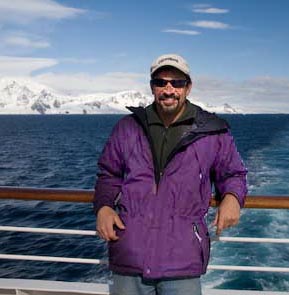
For substantially more information and pictures about this trip please visit Dr. P’s web site.
(after reading about this fantastic trip I was left wondering what gear and other information concerning the technical’s Dr. Palazzolo might be able to provide, so I asked him! He was generous enough to include the information below!)
Dr. P used the Canon 1D Mark III on his Antarctica trip for almost all of the action shots. The good focusing ability (he has never had the infamous Mark III focus problem on this trip), high frame rate and weather proofing in the face of salt spray made this camera a good choice out on the water in the zodiacs. He used the Canon 5D for most of his scenery shots and some of his land shots of penguins. Having two cameras at his disposal minimized lens changing and missed photo opportunities. . Almost all of his shots are RAW. He uses aperture priority for most of his wildlife photography, and tends to use partial and spot metering most of the time.
He usually uses his Canon 500 mm f/4 IS for his wildlife photography due to its optimal combination of size, weight, and focal length. In Antarctica it was not needed. Instead he used the Canon 300 mm f/2.8 IS, sometimes with a 1.4X teleconverter. This combination was used for the whale shots taken from the expedition ship. "The whales came upon us fast and we had to scramble to get on deck and find a good position to shoot. There was no time to play with white balance or make any other significant settings changes".
The biggest shooting challenge of the trip turned out to be the flying petrels and albatross at the back of the boat. With the strong wind the birds literally whipped past. It was good practice trying to lock focus on them, especially with choppy background waves in the same scene.
The majority of time, especially when out on the zodiacs, he used the Canon 70-200 mm f/4 IS. This proved to be a valuable lens, and was used to take the leopard seal photos. The leopard seal shot was taken in difficult conditions. The wind was whipping, the boat was bouncing, and the waves were chopping and sending salt spray. Even the people in the zodiac were moving around and making photography difficult. When Dr. P came across the leopard seal thrashing the Shag in its mouth he had to shoot fast and hope for the best due to all these factors and the fact that the seal was only above surface for a few seconds with the shag in its mouth.
The Canon 24-105 mm f/4 IS was used for the general scenery shots.
When the blue sky was present and the angle right a polarizer filter was used.
On the misty days a plastic sleeve, available for $5 at the local camera shop, fit perfectly over the camera and 70-200 mm. Condensation never seemed to be a problem when moving from indoors to out and back. Probably because the temperature outside ranged from 30-50 degrees Fahrenheit.
Thank you Dr. Palazzolo! I know the time and effort required to put together a piece like this is significant and I’d like to thank you for your time and efforts. I’m sure many readers will find this as fascinating as I did.
Dr. Palazzolo’s contact information:
Carl Palazzolo, DVM, MBA
Long Beach Animal Hospital
3816 E. Anaheim St.
Long Beach, CA 908094
WWW.LBAH.COM
Portraits, Soft Natural Light
This is a continuing take on portraits because portraits seem to be a very popular topic. I’ll often hear from readers who tell me that they can’t take great portraits because they don’t have a studio, or expensive off-camera strobes, or a team of assistants to hold reflectors and flags. Fair enough, but it is possible to capture great portraits using nothing more than your camera and lens. The compromise being that you’ll need to pay attention to the sun, the time of day, and plan carefully for the best natural light. Personally, I think natural light provides the most attractive lighting for portraits period. Let’s look at some portraits I did a while back with three young ladies using nothing more than a camera body and single lens.
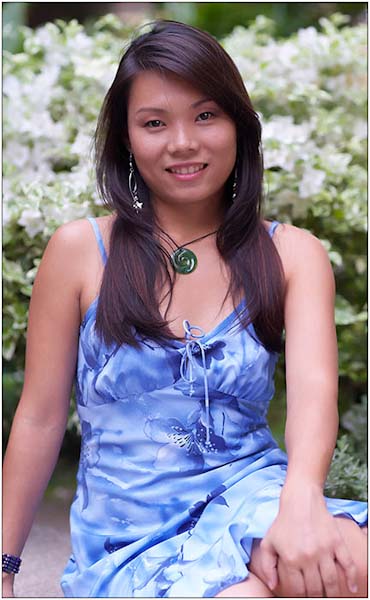
All three wanted their portraits taken in a certain garden. Arriving at the garden all I could see was the very bright sun directly overhead and I wasn’t very hopeful. What do you do when the conditions aren’t right? Stall! The sun and clouds are moving all the time, sometimes just a few minutes can change things. I stalled by discussing poses, print sizes, or anything else on-topic I could think of. Not even ten minutes later the sun went behind some clouds and I knew the time was right.

When the sun went behind the clouds and I told them it was time to take the portraits they looked at me like “are you crazy, can’t you see the sun is behind a cloud?” Reassuring them that this was great light I quickly put them in some poses and within a few minutes had enough material to make them very happy.
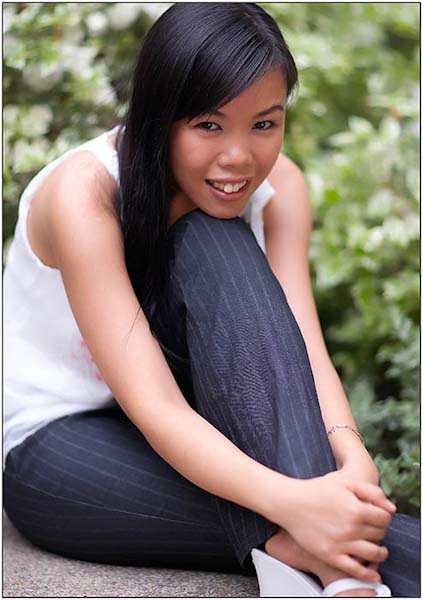
Why would the sun behind the clouds make great light? Because the clouds filter the light and soften it, blanketing the subjects with an even soft light that literally makes their skin glow. How can this be when your eyes are seeing nothing more than unlit dark skin? Remember white balance? That if you shoot in RAW (or evening Jpeg but you must adjust the WB in real time) you can adjust your white balance after the fact?
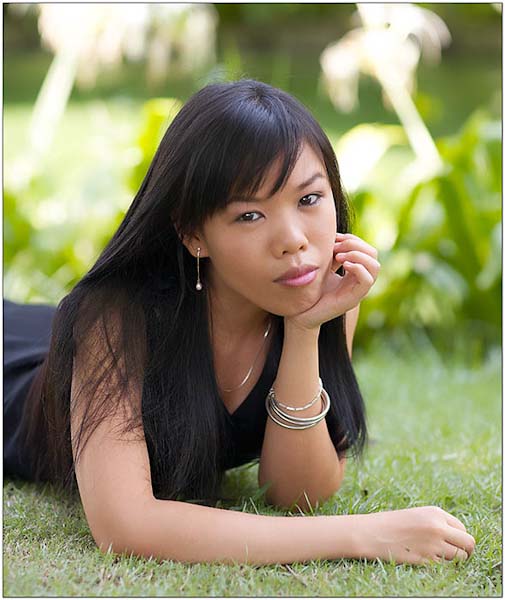
All I had to do was make sure the poses were great and the exposures spot on. Even though on the camera LCD the pictures looked ‘wrong’, I knew I had what I needed. Back on the workstation I simply adjusted the white balance to show the cloud covered temp as daylight temp, and their skin came alive and glowed just like it was under the sun.. but if it really was under the sun it would have been way too harsh and their eyes would be squinting, and the coverage would tend to be very uneven.
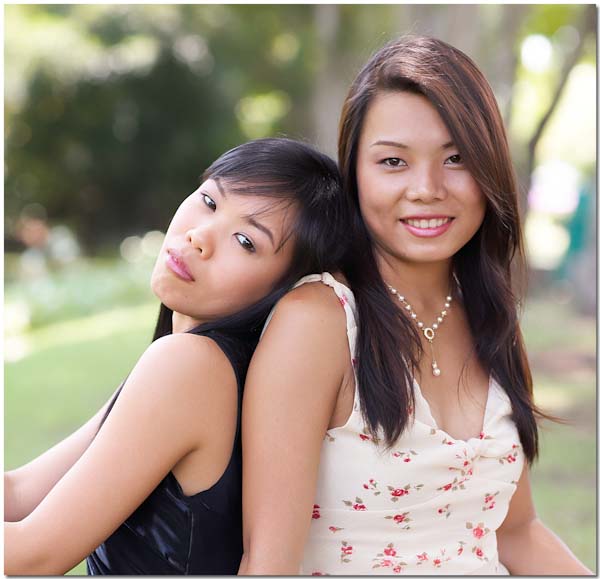
This way I had the best of both worlds. The glowing great color of the sun on their skin, and the soft filtered light you get as sunlight passes through clouds. No other lighting, reflectors, or flags were used.
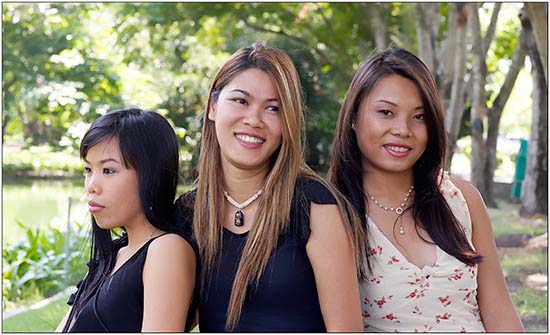
All three girls were more than pleased and I captured some wonderful portraits. All with the sun behind a cloud. Shade would work just as well. Next time you’re out and want to make a portrait, remember a cloudy day or even shade will provide what you need.
Soft filtered light through a cloud or shadows is only one type of natural light. In future columns we’ll be discussing other types of natural lighting and their application to portraits.
Photography News of Interest
I love aerial photography! Local freelance photographer Brian Powers captured the isles of Hawaii. You can read about his efforts here.
Hmm.. I’m a bit confused by this one. A Texas newspaper reports a man was arrested and remains in jail for “improper photography and indecency with a child”, and then the details go on to say he only video taped women and children on school grounds who were “unaware” they were being filmed. Basically, this sounds like they’re using one law to enforce their “no unauthorized filming” rules.. but at what expense? Is this something photographers need to be worried about? You can read more about this here.
Didn’t get enough of the Oscars? Check out this gallery of great images from the red carpet here.
Readers' Submissions
Your blog may not be about Laos but I can still learn from it! I do get to Bangkok periodically, but not quite as often as I like. I'll look up the Canon support office when I'm back next. I've had a good read of your BKKimages site as well and your individual workshops sound really interesting. Right now the timing isn't great for me, but maybe late this year would work. I love photography, and think I have a better than average eye, but I don't know the fundamentals. Let's talk about the possibility more over the next several months.
Feel free to include my email in the reader's questions section.
Oh, and here's a possible entry for the Readers' Submissions – it's a wide angle (17mm) of the That Luang stupa in Vientiane.
Best,
Luke

Luke –
Sorry for not replying sooner. I've been down hard with a stomach bug probably caught at some food vendor's stand.. better today.
Thanks for the submission. I love it! Wonderful shot!
Steve
I suspect the readers submissions will be a highly anticipated section of this column and I encourage anyone with photographs and travel accounts they d like to share to please send them to me at: QandA@Bkkimages.com
Readers Questions
Dear Steve,
I stumbled across your blog from the 20th December today while trying to find prices on the 5d ii (just dreaming about it for now). I really enjoyed what I read and look forward to going through other posts. I'm an amateur photographer in my spare time and work for a development NGO in Lao PDR the rest of the time.
Reading your blog I had a couple of specific questions come to mind. First: I've had my 5d now for a couple of years and have travelled a lot with it and would really like to have it professionally cleaned. What you described about getting your DSLR body and lenses cleaned is exactly what I have wanted! Would you please tell me where they are? Next time I'm through BKK I'll get my stuff professionally cleaned.
Second, given my NGO experience, your blurb about "Flashes of Hope" caught my eye and looked really interesting. Unfortunately the link no longer works. Do you have any other information on them? (Ooops, never mind, just found them in Google! This is pretty interesting!)
Cheers,
Luke
Luke –
I'm glad you found my weekly column. It's not about Laos, but I do get over there from time to time and include my Laos photos when I do.
To answer your questions:
1. Do you ever visit Bangkok? The official Canon service center in Bangkok is very good and inexpensive. They can clean your camera (inside, outside, sensor) while you want (in most cases) and I think the charge is baht 400.. I've used them many times and I've always been very pleased. If you need to send it to them you can find their address under the Canon support site for Thailand..
They're located at:
10th Fl., 179/34-45 Bangkok City tower South Sathorn road, Thungmahamek Sathorn, Bangkok 10120 Tel. (66) 0-2344-9888 Fax. (66) 0-2344-9861
2. The Flashes of Hope program is indeed interesting. I'm glad you found the reference to them useful. Let me know how your contact with them goes.
And if you ever have anything for our Readers Submission section I'm sure there are many readers who would love to see pictures from Laos..
Take care and let me know if I can answer any more questions.
Steve
Please submit your questions to QandA@Bkkimages.com All questions will be answered and most will show up in the weekly column.
A Snapshot of Bangkok Images Week in Review
This week wasn’t very eventful because I was down for most of it with a stomach virus. I hope to accomplish more next week with two scheduled workshops and several new location scouting visits.
Infocus Blog
A few weeks ago a small group of rather accomplished photographers headed up to Nakon Sawan to the Beung Boraphet Nature Preserves.. all wetlands. (next week we’ll feature my attempts at photographing birds..)
Before heading out on the boat we'd arranged for we ate lunch. We placed our gear (mostly big cameras with huge white lenses) on the table next to us while we ate. During the meal we discussed technique, camera settings, lenses, and locations..
All these guys were very good, yet it appeared that almost all of us had our own unique style and preferred to do things our own way. There are many variables in this type of shooting.
At the end of a very long day we all had our flash cards in hand, each person trying hard to conceal their eagerness to get home and fire up the computer to take a look at the day's catch.
I think we prefer to do this in private.. ya know.. just in case we were pure crap that day.. no one looking..
By 3am we'd all been home, showered, eaten, and spent enough time on the computer to email some images back and forth to each other.
They were all really good images! But how can that be if we were all using different gear, settings, and techniques?
The most glaring difference I noted, was that each photographer had developed their own eye.. their own vision. This resulted in as many different types of compositions as there were photographers.
A photographic composition isn't that unlike writing a story. A good composition does indeed tell a story. We were all just telling a different story, from a different perspective, yet we'd all experienced the exact same environment and circumstances.
What could be more human or more beautiful than that?
My gallery for the day can be viewed here.



